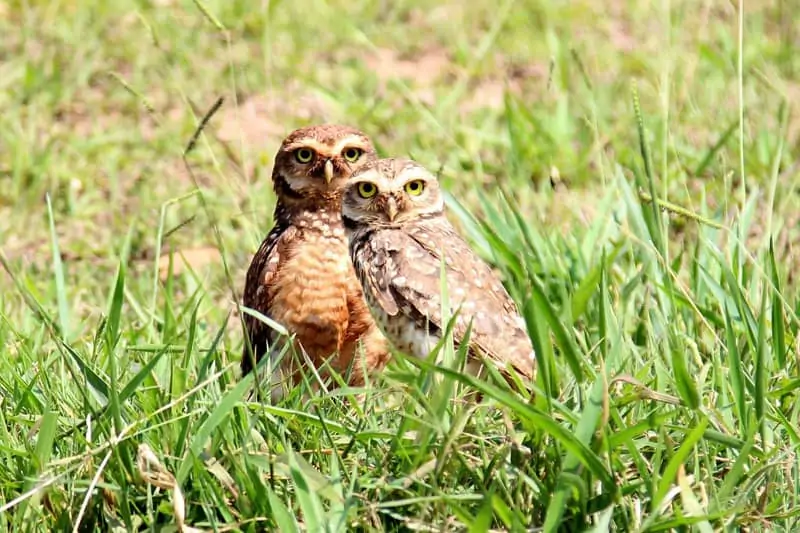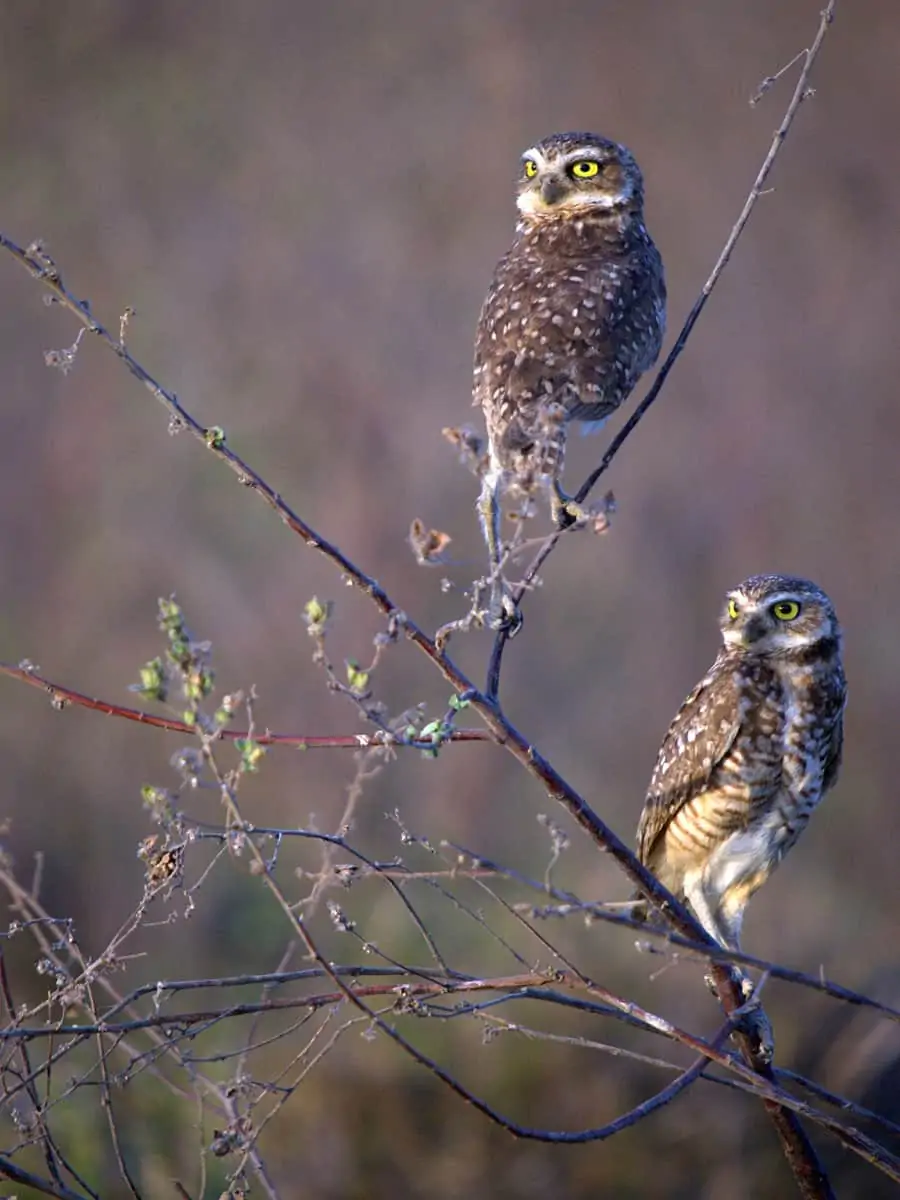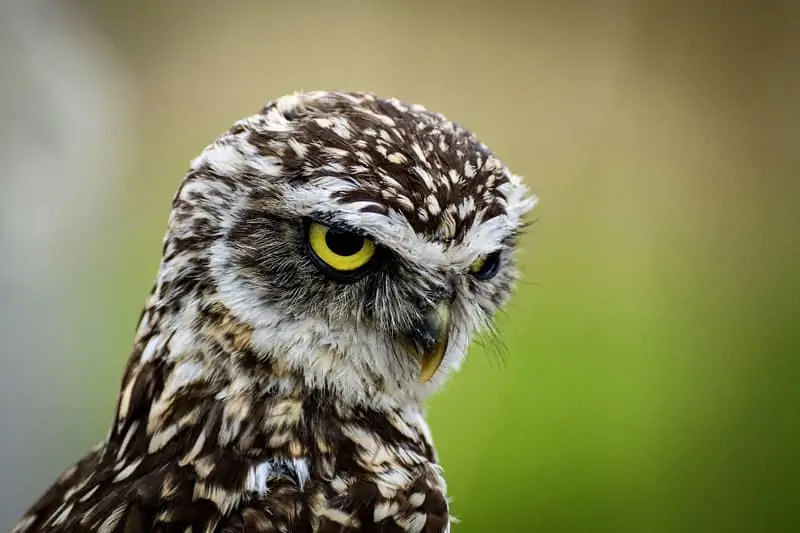Because of their graceful, silent flight, mysterious nocturnal activity, and seemingly all-knowing eyes, owls have been seen as symbols of wisdom, intuition, and the supernatural throughout history.
Yet, beyond the movies, there is a whole universe of owls that varies from what we see.
The Burrowing Owl, for example, is a burrower. Here’s an owl that doesn’t belong with the other Harry Potter Snowy Owls, and as a result, it deserves your attention! It’s an owl that doesn’t quite fit in. We’ve gathered several fascinating facts about Burrowing Owls, which we think are intriguing.
INTERESTING FACTS ABOUT BURROWING OWLS
BURROWING OWL APPEARANCE
1. Among the tiniest owls, burrowing owls come in at a close second. The Burrowing owl weighs just 4-7 ounces with a wingspan of about 2 feet, whereas the European Eagle owl is the biggest owl species with an average weight of 3-8 pounds and a wingspan of over 5 feet.
2. These owls have no ear tufts, giving their heads a humorous, spherical look compared to the Great Horned owl.
3. Their square tails are short, and their legs are long and slender, making them ideal for running on the ground.
4. Brown with white markings on their heads, backs, and chests, and white bellies. The patterns on females may be more obvious than on males.
5. A long white eyebrow runs across their faces, as well.
6. The female is significantly bigger than the male in most owl species. Males and females of Burrowing owls are of the same size, but males may be somewhat larger.
BURROWING OWL HABITAT

7. The Burrowing Owl gets its name from its subterranean habitation.
8. Owls will occasionally dig these burrows, but they’ll typically take over burrows created by other animals like prairie dogs, badgers, ground squirrels, and even tortoises.
9. Throughout North and Central America, burrowing owls may be found in arid plains, grasslands, pastures, and deserts.
10. During warm weather, the owls’ underground burrows will help keep them cool and hydrated.
11.In order to attract insects like dung beetles, one of the owls’ favorite foods, owls will frequently line their burrows with manure. The manure’s aroma is thought to conceal the owls’ scent, protecting them from predators while they sleep.
12. Owls occasionally pick up human trash, such as cigarettes, bottle caps, plastics, and other litter to line their burrows during nesting. They’re thought to do it in order to notify others that their burrow is occupied.
13.They’ve developed a higher resistance to carbon dioxide as a result of their extensive time spent underground and the lack of fresh air flow through their burrows. In situations with mild air quality and minimal fresh oxygen, this adaptation enables them to live.
BURROWING OWL DIET

14. Burrowing owls are mostly active during the day, catching insects, small animals, and occasionally reptiles and amphibians. Other owls hunt at night.
15. Grasshoppers, crickets, beetles, mice, shrews, frogs, lizards, and even young Burrowing Owls are eaten by Burrowing Owls.
16. Owls use their long legs to walk or run across the ground in order to catch prey. They may, however, fly through the air and capture prey on the ground.
17. Males catch mostly small mammals and other vertebrates at night, while females catch the majority of insects during the day.
18. During scarcity or bad luck hunting, owls will store food in their burrows to ensure a sufficient supply, particularly during breeding season.
BURROWING OWL BEHAVIOR

19. Because of the way they stick their heads out from their burrow entrances and nod up and down, cowboys were known to refer to these owls as “howdy birds” or “howdy owls.” Humans, on the other hand, find this conduct attractive and hilarious, yet it is a indication of distress from a predator or other danger.
20. During rainstorms, burrowing owls are quite active performers. These owls have been known to run around and flap their wings, stretch, and shake their feathers when it rains, according to reports.
21. An owl uses a sound that is similar to that of a rattlesnake to frighten away predators when it is in danger. Since the predator doesn’t know if there’s a rattlesnake waiting inside, this works especially well when they’re hidden in their burrows.
22. When they are startled, instead of flying away like other birds, they generally flee or flatten themselves on the ground.
23. In the wild, owls live for 7-8 years, while in captivity, they live for 12 years.
BURROWING OWL MATING & NESTING

24. Owls will engage in a courtship ceremony that entails flying high into the air, swooping or hovering, and then plummeting. It is even possible to repeat this multiple times.
25. Each mating pair looks after the other. Both sexes groom and preen each other, as well as rub beaks together, in the presence of females.
26. In a clutch, mothers lay between 2 and 12 eggs.
27. The eggs are incubated by parents, who spend around four weeks hatching them. The owlets are then shifted back and forth until they fledge (when they gain feathers for flight).
28. Owlets are born with a coating of delicate, light brown downy feathers that make them totally helpless.
29. Owls build loose colonies with numerous nearby burrows when they breed. The additional burrows are thought to offer the juvenile owls various escape options in the event of a impending threat.
BURROWING OWL CONSERVATION

30. Burrowing owls have a complicated conservation status. In Canada and Mexico, they are considered endangered, while in the United States, they are listed as such. States are part of the federal government. Nonetheless, in other categories, they are ranked as least concerned.
31. Their populations have reportedly decreased over time, regardless of their position.
32. Pesticide usage, land development, automobile collisions, and agricultural activities are all threats to these owls.
33. Domesticated and feral cats, as well as other predators like badgers, weasels, hawks, and birds of prey.
